Introduction
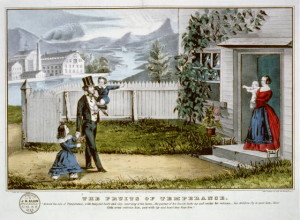
Like many white, middle-class Americans at the time of World War I, the reformers of the United War Work Campaign were attempting to navigate conflicts between traditional gender ideologies and the new cultural developments that challenged those traditions. In the late nineteenth century, Americans placed men and women in separate ideological spheres. In their view, ideal women belonged in the private, domestic sphere, while ideal men belonged in the public, working sphere. By the early twentieth century, however, many women began to challenge the strict division of spheres as they entered the public sphere more both in labor (including white-collar jobs) and in politics (especially by participating in Progressive-Era reform movements).[1]
As the UWWC and its affiliate organizations created ads and other literature for their campaign, they employed images and text that promoted their understandings of gender and womanhood from a primarily white and middle-class perspective while navigating tensions between traditional and liberal gender ideologies.
Women at War and the Public Sphere vs. Domesticity
As some women entered the public sphere in the years surrounding the turn of the century, they did not completely reject more traditional ideologies of womanhood. As early as the mid-1870s, the women of the Women’s Christian Temperance Union (WCTU), though they broke tradition by engaging in a political movement, had to ensure that their political methods were “both effective and ‘womanly.’” Thus, women of the WCTU marched in parades with banners proclaiming “Please vote to protect our homes,” and stood near ballot boxes offering hot lunches, coffee, and bouquets of flowers.[2] Even just before the United States entered World War I, the Woman’s Peace Party focused on rhetoric of motherhood and a female tendency toward peace to argue for pacifism and for the need of a female presence to balance the male-driven world of politics.[3] Pacifist women like Jane Addams claimed that women, as mothers, had nurtured the young soldiers into adulthood, and thus felt a higher needs to protect soldiers’ lives rather than waste them.[4] Ironically, once the United States did enter the war, army propaganda used similar appeals to motherhood to urge women to support the war, with the “symbol of the loving and loyal American Mom” acting both as something for soldiers to protect and as a force for keeping up morale.[5]
Bringing Home to the Front
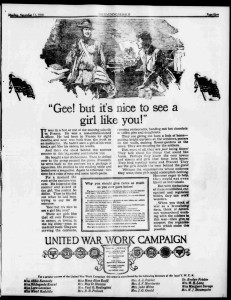
Even as women became increasingly involved in the war, arguments attached to traditional womanhood persisted. The United War Work Campaign and its affiliate groups often used images and rhetoric depicting female war workers as mother and sister figures representing the domestic and bringing home to training camps and to the front. One newspaper ad, for instance, relayed the scene of a soldier’s delight at the sight of a young canteen worker, not out of romantic interest but out of his pleasure at seeing “a girl of his own kind, a girl like his sisters” (Figure 1). The ad went on to describe the ideal American woman who brought home beyond the home front.
There are girls like that all over France—in camps, in towns, in the big cities—even at the front itself. They are serving the canteens, running restaurants, handing out hot chocolate or coffee, pies, and doughnuts.
They are giving the huts a look of home—putting bright curtains at the windows, posters on the walls, making flower-gardens at the doors. They are mending for the soldiers.
But most of all, they are just being there! They talk about the things that sound like home…
…When you think of war as a brutalizing force, think of American womanhood working with the soldiers in this war—then give, to support the organizations which make this possible.[6]
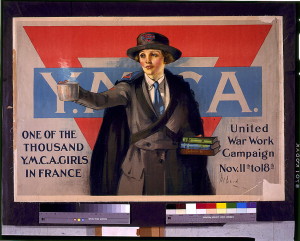
This was the image of the Y.M.C.A. girl, arm outstretched to offer a steaming cup of cocoa and armed with books to offer the soldier a seemly and educational source of recreation (Figure 2). She waited—beautiful and rosy-cheeked but benevolent and modestly dressed—ready to offer an appropriately feminine welcome.
In this manner, the UWWC presented even women who ventured into the public sphere by physically joining the war effort as ambassadors and transporters of the home who only minimally threatened the traditionally domestic American womanhood.
From Another Perspective
The Young Women’s Christian Association, the only women’s group officially involved in the the United War Work Campaign, helped introduce an additional dynamic to depictions of female war workers. While it by no means opposed bringing feelings of home to soldiers, the organization seems to have been somewhat more accepting, if sometimes outwardly skeptical, about women who contributed to the war effort in a less traditional manner.
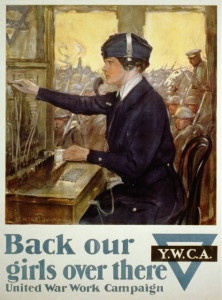
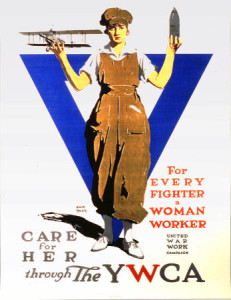
Some campaign advertisements that focused on the YWCA presented images of women on the job—images which, according to historian Nancy Zeiger, were not common in World War I poster art (Figures 3 and 4).[7] Yet the YWCA, whose programs had supported women workers since before the war, did not shy away from showing women engaging in the public sphere. It served the women that these images portrayed, needed the funding to support them, and as a women’s organization stood behind women’s right and responsibility to contribute to the war effort whether at home, in the factory, or overseas.
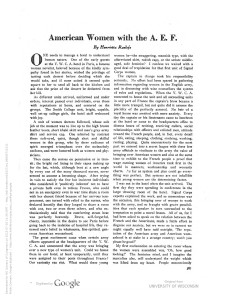
At the same time, YWCA publications sometimes expressed concern that the appearance of war workers remain properly feminine and not overly challenging to traditional womanhood. For example, one article from the YWCA’s Association Monthly reports the trepidation of Association workers overseas as they awaited the arrival of the Signal Corps women they were to serve. The women asked each other whether the new arrivals would be “the swaggering, mannish type, with the abbreviated skirt, rakish caps, or the sedate middle-aged, safe feminist,” and upon seeing the Signal Corps workers were relieved to find them just the right combination of modest and industrious. As Henrietta Roelofs, the author of the article, commented, “Even the two or three bobbed-haired members did not strike one as eccentric, but merely attractive and business-like in their boyishness.”[8]
Ultimately, the YWCA saw the strength of female war workers as a source of pride, often claiming their efficiency to be even better than that of the men who jobs they had replaced. As Roelofs concluded in the Association Monthly, “The army has been more or less timid in assuming the responsibility of having American women mixed up in the army organization. Now that the shock is over, what more sensible course is there to pursue than to release the men for the fighting line and put in their places women, especially when, putting boasting aside, they can undoubtedly do the work better?”[9]
Women, Morality, and Social Hygiene
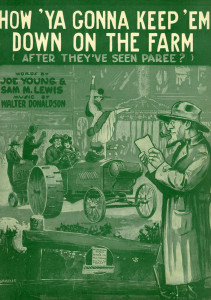
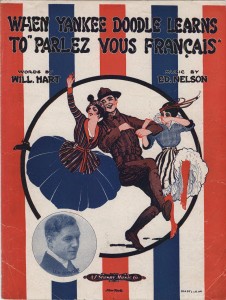
One of the greatest threats the Commission on Training Camp Activities saw to moral camp life was the spread of venereal disease due to the proximity and availability of “loose” women. The concern that women could lure soldiers out of their innocence followed the troops as the U.S. mobilized for war, whether they remained in training camps or traveled overseas, and the reformers who would eventually run the United War Work Campaign became obsessed with what they called “social hygiene.” Fears of immorality even appeared in pop culture, as in this sheet music which shows risque French women tempting American soldiers and leading them astray (Figures 5 and 6).
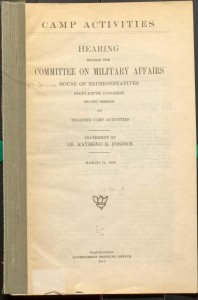
Perhaps most alarming in the minds of reformers was the idea that the women who endangered men were not just prostitutes whom they could isolate, but often simply less-than-reputable women, generally of the lower class, who came directly to camps rather than working in red-light districts. In a hearing before the House of Representatives’ Committee on Military Affairs in March, 1918, Raymond Fosdick discussed this concern with Congressman Julius Kahn. The two referred to these women as “semiprostitutes” and “flappers…the young girls who were not prostitutes but probably would be to-morrow, and who were diseased and promiscuous.”[10] This conversation exemplified a tendency in the statements and literature distributed by the Commission on Training Camp Activities to blame lapses in social hygiene primarily on women, regarding them as temptresses who convinced men to abandon morality and follow their sexual instincts.
Paradoxically, while reformers tended to blame women for the persistence of immorality, they did not do so because they saw women as generally immoral—indeed, quite the opposite was true. According to historian Nancy Bristow, the Commission on Training Camp Activities and its affiliates generally charged women with the responsibility of keeping men away from immoral behavior in part because of “the reformers’ continued attachment to the notion of women as the natural moral superior of men.”[11] As a result, reformers could simultaneously blame women who forsook morality to tempt men, and appeal to women as the most powerful voice in keeping soldiers out of trouble, as they did by sending out female war workers.
As with the YWCA’s depictions of women at work, women writing about the issue of sexual immorality were often more lenient when it came to traditional views of womanhood. While the groups of the United War Work Campaign frequently interpreted women’s traditional moral superiority as a reason to make them responsible for preventing venereal disease, the women of those groups were more willing to entertain the idea that men should take more blame and responsibility. Members of the YWCA in particular were concerned not just for the prevention of disease in the ranks, but for the protection of female civilians, whom they viewed as potential victims of uncontrolled soldiers rather than just as dangerous temptations.[12]
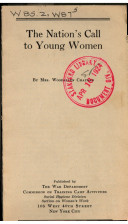
A similar perspective appeared in a social hygiene pamphlet published by the Commission on Training Camp Activities Social Hygiene Division Section on Women’s Work (Figure 7). Entitled The Nation’s Call to Young Women and written by a woman, Rose Woodallen Chapman, the pamphlet rebuked those who had dismissed men’s sexual immorality as natural and asserted that it was the man who “must exert the self-control needed to keep him in the path of duty.” Despite this initially more equitable view, however, the pamphlet indicated that female reformers did not stray far from the Commission on Training Camp Activities’ tendency to pin responsibility on women. Chapman went on to say that since men often fall short of self-control, women must be the “added impetus” which prevented men from going too far.[13] Then, she spent most of the remainder of the pamphlet explaining how if a man turned to prostitution, it would likely be a woman’s fault for either encouraging him or not providing adequate discouragement.
Female reformers’ perspectives on morality, like their perspectives on women workers, tended to stretch the boundaries of tradition further than did the more numerous male leaders of the Commission on Training Camp Activities and its affiliate organizations. Even if the women of these groups stretched these limits, though, they did not intend to break them, and depictions of women in Commission on Training Camp Activities literature remained paradoxically situated between morality and immorality.
[1]Nancy K Bristow, Making Men Moral: Social Engineering during the Great War (New York: New York University Press, 1996), 27-9.
[2]Rebecca Edwards, Angels in the Machinery: Gender in American Party Politics from the Civil War to the Progressive Era (1997), 42-50 in Leon Fink, Major Problems in the Gilded Age and the Progressive Era (Stamford: Cengage Learning, 2015), 200-4.
[3]Linda Schott, “The Woman’s Peace Party and The Moral Basis for Women’s Pacifism,” Frontiers: A Journal of Women Studies 8, no. 2 (1985).
[4]Schott, “The Woman’s Peace Party,” 20-21.
[5]Susan Zeiger, “She Didn’t Raise Her Boy to Be a Slacker: Motherhood, Conscription, and the Culture of the First World War,” Feminist Studies 22, no. 1 (Spring 1996): 6–39.
[6]“Gee! But It’s Nice to See a Girl like You!,” The Evening Herald, November 11, 1918. Emphasis added.
[7]Susan Zeiger, In Uncle Sam’s Service: Women Workers with the American Expeditionary Force, 1917-1919 (Ithaca, N.Y: Cornell University Press, 1999), 87.
[8]Henrietta Roelofs, “American Women with the A.E.F.,” Association Monthly, October 1918.
[9]Roelofs, “American Women with the A.E.F.,” October 1918.
[10]Camp Activities: Hearing before the Committee on Military Affairs (Washington: Government Printing Office, 1918), 5.
[11]Bristow, Making Men Moral, 48
[12]Nancy Marie Robertson, Christian Sisterhood, Race Relations, and the YWCA, 1906-46 (Urbana: University of Illinois Press, 2007), 48.
[13]Rose Woodallen Chapman, The Nation’s Call to Young Women (New York: War Department, Commission on Training Camp Activities, 1918), 6-8. Accessed in Rare Book and Special Collections Division, Library of Congress.